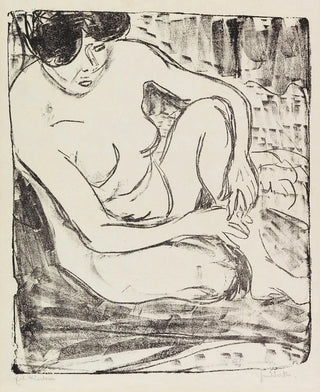Painting Study of an Act - Ernst Ludwig Kirchner | Art print


View from behind

Frame (optional)
Ernst Ludwig Kirchner's "Étude d'acte" is an iconic piece that invites a profound exploration of the human condition and the beauty of the body. Kirchner, a major figure of the expressionist movement, manages to transcend mere representation to offer a reflection on the psyche and sensuality. In this artwork, every brushstroke, every shade of color seems to vibrate with an emotional intensity that leaves no one indifferent. This study, far from being a simple sketch, asserts itself as a cry of the soul, an invitation to delve into the artist's turbulent universe. The art print of this piece allows for a rediscovery of Kirchner's evocative power, while adding a touch of elegance to any interior.
Style and uniqueness of the artwork
The piece stands out for its bold use of colors and shapes, characteristic of the expressionist style. Kirchner plays with contrasts, creating a dialogue between shadows and lights that enhances the depth of the figures. The bodies, stylized and distorted, seem to dance across the canvas, capturing a movement that is both graceful and disjointed. This approach demonstrates a desire to go beyond tangible reality to touch the very essence of emotion. The sinuous lines that outline the silhouettes evoke a palpable sensuality, while hinting at an underlying fragility. Every element of the work contributes to creating an atmosphere that is both intimate and universal, where the viewer is invited to feel rather than analyze. The visual power of "Étude d'acte" lies in its ability to capture the fleeting moment of human emotion, while leaving room for personal interpretation.
The artist and his influence
Ernst Ludwig Kirchner, born in 1880, was one of the founders of the group Die Brücke, which played a central role in the development of German expressionism. His work is marked by a quest for artistic freedom and a desire to break away from academic conventions. Kirchner drew inspiration from urban life, natural landscapes, and non-Western cultures, integrating these influences into a unique style that is entirely his own. His commitment

Matte finish

View from behind

Frame (optional)
Ernst Ludwig Kirchner's "Étude d'acte" is an iconic piece that invites a profound exploration of the human condition and the beauty of the body. Kirchner, a major figure of the expressionist movement, manages to transcend mere representation to offer a reflection on the psyche and sensuality. In this artwork, every brushstroke, every shade of color seems to vibrate with an emotional intensity that leaves no one indifferent. This study, far from being a simple sketch, asserts itself as a cry of the soul, an invitation to delve into the artist's turbulent universe. The art print of this piece allows for a rediscovery of Kirchner's evocative power, while adding a touch of elegance to any interior.
Style and uniqueness of the artwork
The piece stands out for its bold use of colors and shapes, characteristic of the expressionist style. Kirchner plays with contrasts, creating a dialogue between shadows and lights that enhances the depth of the figures. The bodies, stylized and distorted, seem to dance across the canvas, capturing a movement that is both graceful and disjointed. This approach demonstrates a desire to go beyond tangible reality to touch the very essence of emotion. The sinuous lines that outline the silhouettes evoke a palpable sensuality, while hinting at an underlying fragility. Every element of the work contributes to creating an atmosphere that is both intimate and universal, where the viewer is invited to feel rather than analyze. The visual power of "Étude d'acte" lies in its ability to capture the fleeting moment of human emotion, while leaving room for personal interpretation.
The artist and his influence
Ernst Ludwig Kirchner, born in 1880, was one of the founders of the group Die Brücke, which played a central role in the development of German expressionism. His work is marked by a quest for artistic freedom and a desire to break away from academic conventions. Kirchner drew inspiration from urban life, natural landscapes, and non-Western cultures, integrating these influences into a unique style that is entirely his own. His commitment
12,34 €






